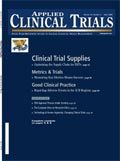Investigational Medicinal Products— Optimizing the Supply Chain
A delay in receiving one piece of information may have a severe impact on later parts of the process, such as label text.
There are many issues that clinical project managers need to address during the course of running a clinical trial. One issue that is mostly outside of their remit, and which many may feel relatively powerless to influence, is the supply chain for investigational medicinal products (IMPs).

The manufacture and packaging of medicines for use in clinical trials can appear, on the face of it, a fairly straightforward exercise. In reality, it may be a complex logistical challenge which is often grossly underestimated. This is true worldwide, although the issues are compounded for multinational studies. Recent legislation in the EU has added yet more hurdles to overcome.
This article will review the current regulatory framework as well as the process for supplying IMPs, and then consider possible options that may improve the supply chain.
Regulatory requirements for IMPs
Fundamental to the process for preparing IMPs is the need to comply with the requirements of good manufacturing practice (GMP). These requirements are now law in both the United States—21 CFR Parts 210 and 211, and "Guideline on the Preparation of Investigational new Drug Products," March 1991
1
—and the European Union—Clinical Trials Directive (2001/20/EC
2
).
The UK Medicines and Healthcare Products Regulatory Agency (MHRA) defines GMP as "that part of quality assurance which ensures that medicinal products are consistently produced and controlled to the quality standards appropriate to their intended use and as required by the marketing authorisation (MA) [or clinical trial authorisation (CTA)] or product specification. GMP is concerned with both production and quality control."
This definition can also apply to all international regions, and its principles are generally well established for commercial manufacturers of marketed pharmaceutical products. However, the preparation of IMPs present extra challenges and complexity, and for this reason extra controls are required to guarantee their quality. These were published as guidelines in the EU until very recently, and compliance was largely voluntary. These guidelines are found in Annex 13 to the EU GMP guide,3 "Manufacture of Investigational Medicinal Products."
However, the status of these guidelines were recently changed via article 13 of the EU Clinical Trials Directive. Since May 2004, the requirements have been mandatory. Also, Annex 13 has recently undergone review, with a final version published in July 2003.4 The purpose of Annex 13 is to ensure that trial subjects are not placed at risk and trial results are not affected by unsatisfactory manufacture. It makes it very clear that, compared to marketed products, there may be added risks to patients taking part in clinical trials as a result of:
- lack of fixed routines or validated processes
- variety of clinical trial designs and consequent packaging designs (including randomization)
- increased risk of product cross contamination and mix-up due to the requirement for blinding
- incomplete knowledge of the potency and toxicity of the product.
In reality, many companies were already complying with the intent of Annex 13 (at least for Phase II studies onwards), and so its transition into law will not have created too many issues.
However, there are also some extra requirements for IMPs as a result of the EU CT Directive. Some EU member states were already imposing at least some of these requirements through their own individual regulatory systems. For other member states, these requirements have created bigger issues to resolve, even though most people recognize the benefits to be gained from increased safety for the patient.
Product details are to be registered via the CTA. This is of particular significance in the United Kingdom for Phase I trials, where previously there was no requirement for a regulatory submission. This has had a major impact on the flexibility of carrying out Phase I studies in the United Kingdom.
All IMPs are to be manufactured, packaged, and assembled in licensed facilities subject to regulatory inspection. This is a new requirement in the United Kingdom and several other EU member states, and has had a major impact on many small units that manufacture, package, and assemble IMPs. Some have consequently taken the strategic decision to close their IMP manufacturing operation.
All IMPs may only be used after being released by a Qualified Person (QP). This is a new requirement in the United Kingdom and several other EU member states. Previously, QP release was only required for marketed products.
Products (including comparators) that are imported from countries outside the EU are subject to a release by a QP. The release will be at the QP's discretion, but will be based on a quality assessment of the manufacturing site. The depth of assessment will be dependant on recognized standards of GMP in that country. The QP will decide if full analytical testing is required on a case-by-case basis.
This requirement creates major issues with sourcing comparators from outside the EU. It is still early, but the industry expects to face major obstacles in verifying the quality of imported products manufactured by competitor companies. Some EU member states have chosen to apply more stringent requirements for using imported products in their country (e.g., insisting on full analytical testing or an inspection of the manufacturing site by the countries regulatory authorities), even though it has been stated that this is not the intent of the directive. This will create further problems for multinational studies using sites in these countries, since the highest standard tends to become the common denominator.
The supply process for IMPs
In order to comply with the regulations, a sequence of steps must be followed and cannot be bypassed (Figures 1 and 2).
Many of these steps can be carried out in parallel with other steps, as indicated in the flow diagrams, and can be used to reduce the overall cycle time. However, other steps must happen in strictly sequential order for each new batch of product or each new packaging job. As can be seen, there are many interdependencies. This means that a delay in receiving one piece of information may have a severe impact on later parts of the process, such as label text. In many cases there is no alternative to following the whole process from start to finish. With other examples, a reduction in cycle time or increased flexibility can be achieved with some forward planning or change in approach, so that at least some of these steps can be reduced or eliminated.

Figure 1. Making the product available is the first step in the process when supplying investigational medicinal products.
Optimizing the IMP supply chain
The following are some of the types of issues that clinical project managers may experience with their IMP supply chains:
- insufficient flexibility
- lack of responsiveness
- complex supply chain
- long lead times (initial supplies and resupplies)
- late delivery (delaying the start of the study)
- poor communication

Figure 2. Labeling, assembling, and shipping the product completes the process. Many of these steps can be carried out in parallel with other steps, and these can be used as opportunities to reduce the overall cycle time.
The result will be a high level of frustration. However, before looking for ways to improve the situation, the first thing to do is to consider your own expectations and how they match with the following facts of life:
- The larger the number of variations of products, packaging, or labeling within or between studies, the more complex the process, and the slower and less efficient the supply chain.
- The earlier that requirements are defined, the greater the likelihood that the IMP team will meet your study start date.
- If the needs of the clinical trial changes after the IMP process has started, and as a result more product needs to be manufactured or the packaging format or labeling has to change, then this will inevitably result in a delay in supply delivery.
If, after due consideration, you are happy that your expectations of the supply chain are reasonable, then the following are some options you could consider in partnership with your IMP supply team.
1) Improve planning
Most companies have a finite number of people available, and need to plan for future peaks and troughs in workload. The IMP team is no different in this regard. It is in your interest to ensure that you provide them with sufficient and meaningful information to allow them to plan future workload. You may not yet know details of numbers of patients, countries, and duration of treatment for future studies, but you could probably make some intelligent guesses that will give the IMP team some idea of the scale and complexity of the study. Obviously, you will need to ensure that your senior managers are happy to accept both the risks and benefits associated with these educated guesses.
2) Make a contract
Your company will have some means for the clinical team to place an order with the IMP team. Best practice is for you to consider this order as a contract, i.e., "an agreement under which two parties make reciprocal commitments in terms of their behavior to co-ordinate."5 The clinical team undertake to provide the IMP team with the following critical pieces of information at the specified points in time: definition of comparators, numbers of patients, number and definition of countries, packaging format, label text, and randomization code. In turn, the IMP team undertakes to provide the clinical team with the specified IMPs by the specified date. If both parties recognize and honor their individual obligations, then everyone's expectations are fulfilled. However, as we all know, things change. In these circumstances, the two teams should work together to resolve arising issues rather than simply expect the IMP team to absorb any changes and still meet the original delivery date.
3) Introduce standardization
Consider agreeing on a standard set of products (formulations and comparators) or pack formats for use across a number of studies within a program, or to use the same pack format throughout all stages on a single study. This may give the potential for the IMP team to stockpile product, which may enable them to eliminate a manufacturing or primary packaging step when you request new supplies. One option for standardizing pack formats is to consider the use of bottles instead of blister packs. The lead times for this are shorter as well. Another potential area for standardization is label format and text. Standardization of text can be of particular benefit where translations are required. This provides the IMP team with an opportunity to develop a database of translations for a number of standard phrases. Therefore, when a new study is initiated the step of requesting translations for label text can be eliminated, saving the time of IMP and clinical staff, and reducing the cycle time.
4) Define variables early
The earlier you can define the significant variables (comparators, label text, pack format, countries), the sooner the IMP team can get on with their job. However, often you may not be able to define these in the time frame required by the IMP team for legitimate reasons. In this case, there are a number of options. A question to ask is "what is the level of uncertainty?" Is it possible to assess the risk of choosing a particular option versus the benefit of reducing the lead time? Obviously, this needs to be done within a culture of shared responsibility and avoidance of blame if the chosen option turns out to be wrong.
Another possibility is to agree upon a strategy where supplies are prepared to cover more than one possible study design option. A bit of extra effort up front may reap rewards for the business as a whole later on in terms of reduced cycle time. However, some time may be needed to convince the IMP team that this strategy is worthwhile—no one wants to do extra work unless absolutely necessary.
5) Build in flexibility
If you are not certain about recruitment levels in each country, then multilingual labeling is inevitable to allow flexibility. This may be achieved by including several languages on a single panel label. For larger studies, the use of a booklet label becomes the most flexible solution, if not always a favorite. If the countries cannot be defined in sufficient time for the IMP team to obtain translations and generate labels, is it possible for instance to agree that the study will use six countries from a pool of 10? Labels can be prepared for the 10 countries, with the knowledge that labels for four countries will be redundant. Or these extra countries may be the ones targeted at a later date if initial recruitment targets are not met. Again, there may be some extra work up front, but with the significant overall benefit of reduced cycle time.
Alternatively, consider whether "just-in-time" labeling or distribution (where centers only receive patient packs when they are required) is possible. The use of an interactive voice response system (IVRS) can facilitate this process.
There is one challenge that faces IMP teams that to date no satisfactory flexible solution has been implemented. This is the issue of relabeling of expiry dates, a particular problem in the EU. Despite much lobbying, the EU pharmaceutical industry has failed to convince the EU regulatory bodies that there are satisfactory alternatives to the inclusion of an expiry date on the label. With current paper-based systems, there are limited options to address the extension of expiry dates in the clinic. Most companies accept that they have no alternative but to distribute small expiry date labels to numerous clinics on a regular basis. An alternative is to adopt the "just-in-time" labeling approach, i.e., an expiry date is only added to the label at the point of dispatch, allowing the longest possible date to be assigned. However, this is by no means a complete solution to the problem. It has a high cost associated with it in terms of resource, and there are also some GMP issues.
6) Use an IVRS
Many companies are now using IVRS to either facilitate data collection and/or facilitate the IMP supply chain.
6
They have certainly been particularly useful in helping IMP teams manage the distribution of complex studies, in particular those involving dose titration or where drug product is in short supply. However, the use of IVRS comes at a cost. For complex studies, it is fairly easy to justify this extra cost due to the obvious reduction in resource and drug product used to pack these studies. For less complex studies, the benefits are harder to demonstrate. Many companies will avoid using IVRS unless the benefits are very clear. However, where IVRS has been used as standard across a number of studies, significant reductions in the quantity of supplies that are produced across the board have been seen. This has a knock on effect to earlier parts of the development process, in particular manufacture of dosage forms, sourcing of comparators, and also production of the API (drug substance). Many departments benefit from this reduction in work load, producing an overall benefit for the whole company.
The future
As the demand for increased flexibility increases, with the need to do more with less and also the much debated trend towards personalized health care,
7
the traditional approach to the preparation of IMPs is unlikely to cope. More responsiveness and flexibility will become a necessity. A move toward the "just-in-time" individualized approach to labeling and assembly is likely to be needed for the future. Different technologies are being considered by the industry, which may facilitate this change in approach. One idea is the use of smart (RFID) chips embedded in either packs or labels, integrated with electronic batch processing.
8,9
There are still significant technical and regulatory issues to overcome, and its implementation may be some way off.
Summary
In summary, the key to optimizing the IMP supply chain is to make good decisions as early as possible, building in flexibility wherever feasible to help you cope with the unexpected. This can be achieved by close cooperation and understanding between the clinical and IMP teams. It will save a whole lot of time, stress and inconvenience down the line, and therefore money!
References
1. http://
www.fda.gov/cder/regulatory/applications/compliance.htm
2. Directive 2001/20/EC of the European Parliament and the Council of 4 April 2001 on the approximation of the laws, regulations and administrative provisions of the Member States relating to the implementation of good clinical practice in the conduct of clinical trials on medicinal products for human use, Official Journal of the European Communities, L121, 34-44 (2001).
3. Good Manufacturing Practice for Medicinal Products (The Rules Governing Medicinal Products in the European Community, Volume IV).
4. http://
5. E. Brousseau and J.-M. Glachant, The Economics of Contracts (Cambridge, Cambridge University Press, 2002).
6. N. Dowlman et al., "Optimizing the Supply Chain Through Trial Simulation," Applied Clinical Trials, 13 (7) (July 2004).
7. "Personalized Healthcare 2010—Are You ready for Information-based Medicine?" IBM Business Consulting Services, http://www-1.ibm.com/industries/lifesciences/doc/content/resource/insight/992104121.html
8. "IBM Solutions for Radio Frequency Identification—The Seamless Supply Chain," IBM Business Consulting Services. http://www-1.ibm.com/solutions/businesssolutions/doc/content/bin/EPC_brochure_Sept2003.pdf
9. S. Greengard, "A Healthy Dose of RFID," RFID Journal, February 2004.
Lesley George, BSc, MRPharmS, is a consultant pharmacist with Oak Pharmaceutical Services, based near Cambridge, UK, +44 (0) 1763 274489, email: lesley@oakpharma.com, www.oakpharma.com.

Improving Relationships and Diversifying the Site Selection Process
April 17th 2025In this episode of the Applied Clinical Trials Podcast, Liz Beatty, co-founder and chief strategy officer, Inato, discusses a number of topics around site engagement including community-based sites, the role of technology in improving site/sponsor relationships, how increased operational costs are impacting the industry, and more.